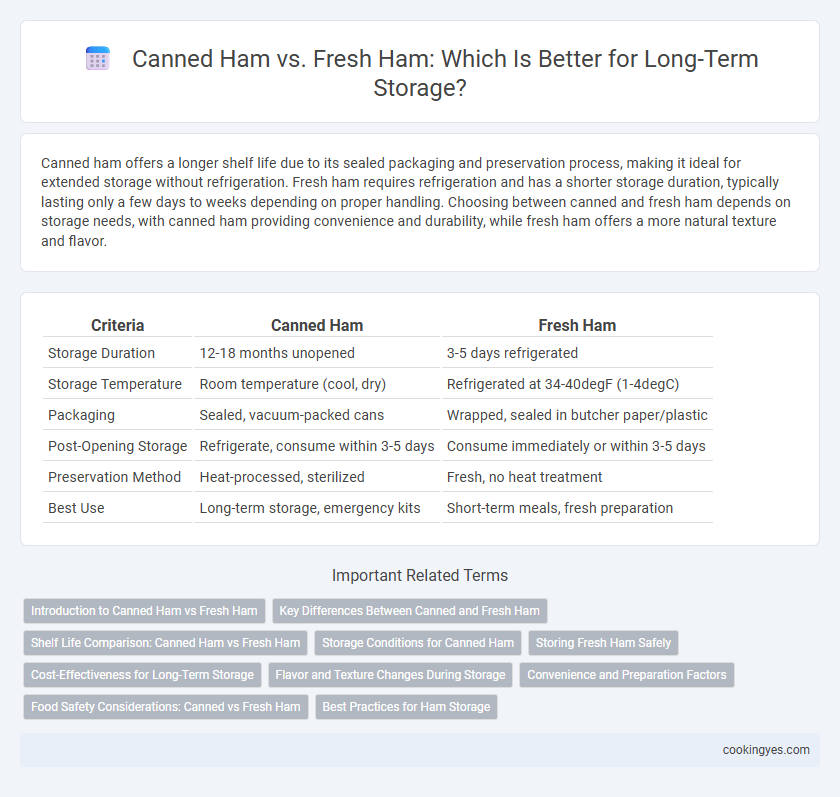Canned ham offers a longer shelf life due to its sealed packaging and preservation process, making it ideal for extended storage without refrigeration. Fresh ham requires refrigeration and has a shorter storage duration, typically lasting only a few days to weeks depending on proper handling. Choosing between canned and fresh ham depends on storage needs, with canned ham providing convenience and durability, while fresh ham offers a more natural texture and flavor.
Table of Comparison
| Criteria | Canned Ham | Fresh Ham |
|---|---|---|
| Storage Duration | 12-18 months unopened | 3-5 days refrigerated |
| Storage Temperature | Room temperature (cool, dry) | Refrigerated at 34-40degF (1-4degC) |
| Packaging | Sealed, vacuum-packed cans | Wrapped, sealed in butcher paper/plastic |
| Post-Opening Storage | Refrigerate, consume within 3-5 days | Consume immediately or within 3-5 days |
| Preservation Method | Heat-processed, sterilized | Fresh, no heat treatment |
| Best Use | Long-term storage, emergency kits | Short-term meals, fresh preparation |
Introduction to Canned Ham vs Fresh Ham
Canned ham offers a significantly longer shelf life compared to fresh ham, making it ideal for long-term storage without refrigeration. Fresh ham requires cold storage and has a limited use-by date, typically lasting only a few days to a week when properly refrigerated. The preservation process of canned ham includes cooking and sealing in airtight containers, which prevents spoilage and extends its usability for months or even years.
Key Differences Between Canned and Fresh Ham
Canned ham offers a longer shelf life due to its preservation through sealing and cooking, making it ideal for extended storage without refrigeration, whereas fresh ham requires refrigeration or freezing to prevent spoilage. The moisture content in canned ham is lower, resulting in a denser texture compared to the juicier and more flavorful fresh ham. Nutrient retention varies, with canned ham often containing higher sodium levels due to curing, while fresh ham retains more natural proteins and vitamins when properly stored.
Shelf Life Comparison: Canned Ham vs Fresh Ham
Canned ham offers a significantly longer shelf life compared to fresh ham, typically lasting up to one year or more when stored in a cool, dry place thanks to its airtight sealing and preservation methods. In contrast, fresh ham must be refrigerated and usually remains safe for 3 to 5 days before spoilage, or up to 6 months if properly frozen. The extended shelf life of canned ham makes it a more convenient option for long-term storage and emergency food supplies.
Storage Conditions for Canned Ham
Canned ham offers superior storage advantages due to its airtight sealing and thermal processing, allowing it to remain shelf-stable for up to two years without refrigeration. It requires storage in a cool, dry place away from direct sunlight to maintain quality and prevent spoilage. Once opened, canned ham should be refrigerated and consumed within 3 to 5 days to ensure safety and freshness.
Storing Fresh Ham Safely
Fresh ham requires refrigeration at temperatures below 40degF (4degC) to prevent bacterial growth and should be stored in its original packaging or tightly wrapped in plastic wrap or aluminum foil. For longer storage, fresh ham can be frozen at 0degF (-18degC), maintaining quality for up to six months when properly sealed in airtight containers or vacuum-sealed bags. Avoid leaving fresh ham at room temperature for more than two hours to reduce the risk of foodborne illness.
Cost-Effectiveness for Long-Term Storage
Canned ham offers superior cost-effectiveness for long-term storage due to its extended shelf life of up to two to five years without refrigeration, reducing spoilage and waste. Fresh ham requires immediate refrigeration or freezing, increasing energy costs and the risk of spoilage over time. The initial higher price of canned ham is offset by its durability and minimal storage requirements, making it a practical choice for budget-conscious consumers or emergency preparedness.
Flavor and Texture Changes During Storage
Canned ham retains moisture and flavor better than fresh ham during extended storage due to its airtight sealing and cooking process, which helps preserve its tender texture. Fresh ham, while offering a more natural and robust flavor initially, tends to dry out and develop tougher textures over time without proper curing or refrigeration. The enzymatic activity and oxidation in fresh ham can also cause flavor degradation, whereas canned ham's preservation methods slow down these quality changes.
Convenience and Preparation Factors
Canned ham offers superior convenience with its long shelf life of up to two years and minimal preparation required, making it an ideal option for quick meals and emergency storage. Fresh ham demands refrigeration and has a shorter shelf life of about 3 to 5 days uncooked, necessitating more careful handling and preparation. The ease of use and extended storage capabilities make canned ham a practical choice for those prioritizing convenience and minimal preparation.
Food Safety Considerations: Canned vs Fresh Ham
Canned ham offers a longer shelf life due to its sealed, sterilized packaging that prevents bacterial growth, making it safer for extended storage without refrigeration. Fresh ham requires proper refrigeration or freezing and has a shorter shelf life, increasing the risk of spoilage and foodborne pathogens if not handled correctly. Proper storage temperatures and expiration monitoring are critical to maintaining food safety for fresh ham compared to the more stable canned ham.
Best Practices for Ham Storage
Canned ham offers superior shelf stability due to its sealed, vacuum-packed environment, allowing it to be stored at room temperature for up to two years without spoilage. Fresh ham requires refrigeration at or below 40degF and should be consumed within five to seven days or frozen at 0degF for up to six months to maintain quality. Proper wrapping in moisture-proof paper or airtight containers is essential for both types to prevent dehydration and contamination during storage.
Canned ham vs fresh ham for storage Infographic

 cookingyes.com
cookingyes.com